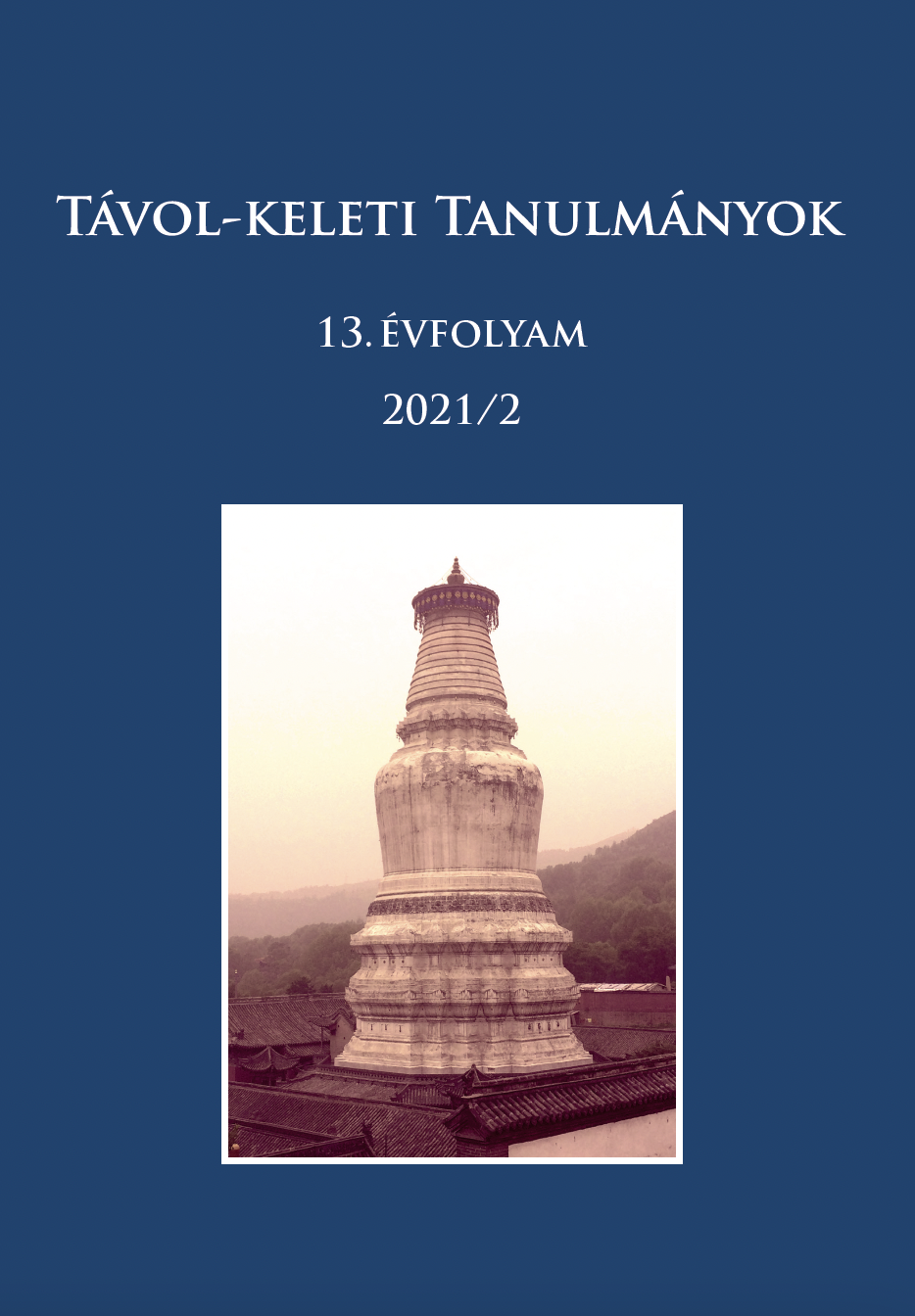Published 2022-09-05
Keywords
- freedom of research,
- higher education,
- Meiji Japan,
- Kume Kinutake,
- Tomizu Hirondo
- Shinto,
- Russo–Japanese war ...More
How to Cite
Copyright (c) 2022 Balázs Szabó

This work is licensed under a Creative Commons Attribution-NonCommercial 4.0 International License.
Abstract
The budding Meiji state, in its pursuit of Western technology, recognised that in order to understand it fully the introduction of basic sciences and scientific methods was also necessary – this led to the establishment of modern Japanese higher education, with the Tokyo Imperial University as its first result. Although in accordance with the development of scientific and academic spheres corresponding ideas of university autonomy and freedom of research were introduced, it was not long before conflict broke out between the government, which was in the very process of creating the ideological foundations of the nation, and academics publishing their results. In this article I aim to examine two of these cases: the Kume incident of 1893 and the Tomizu affair of 1905. Both cases ended with the suspension, and then the dismissal of the professors, but there were significant differences: while in the case of the historian Kume Kunitake the government pushed its decision through without any opposition from the university, the Tomizu affair ended in a scandal which rocked the whole Japanese academic world, forcing the government to retreat.
References
- Breen, John 1996. “The Imperial Oath of April 1868: Ritual, Politics, and Power in the Restoration.” Monumenta Nipponica, 51.4: 407–29. https://doi.org/10.2307/2385417
- Brownlee, John S. 1983. History in the service of the Japanese nation. Toronto: University of Toronto – York University.
- Brownlee, John S. 2000. “Why prewar Japanese historians did not tell the truth?” The Historian 62.2: 343–356. https://doi.org/10.1111/j.1540-6563.2000.tb01444.x
- Chamberlain, Basil Hall 1890. Things Japanese. Being notes on various subjects connected with Japan. London: Kegan Paul, Trench, Trübner & Co.
- Gordon, Andrew 1988. “The Crowd and Politics in Imperial Japan: Tokyo 1905-1918.” Past & Present 121: 141–170. https://doi.org/10.1093/past/121.1.141
- Hall, John Whitney 1965. “Changing conceptions of the modernization of Japan.” In: Marius B Jansen ed. Changing Japanese Attitudes Toward Modernization. Princeton: Princeton University Press, 7–42. https://doi.org/10.1515/9781400875672-002
- Hardacre, Helen 1988. “The Shintō Priesthood in Early Meiji Japan: Preliminary Inquiries.” History of Religions 27.3: 294–320. https://doi.org/10.1086/463124
- Ienaga Saburō 家永三郎 1972. Tsuda Sōkichi no shisōshiteki kenkyū 津田左右吉の思想史的研究. Tokyo: Iwanami.
- Jones, H. J. 1974. “Bakumatsu foreign employees.” Monumenta Nipponica 29.3: 305–327. https://doi.org/10.2307/2383670
- Kume Kunitake 久米邦武 1989. „Komonjo no kenkyū 古文書の研究 [A régi dokumentumok vizsgálata].” In: Ōkubo Toshiaki et al. eds. Kume Kunitake rekishi chosaku shū 4. Tokyo: Yoshikawa Kōbunkan.
- Kuroda, Toshio – Dobbins, James C. – Gay, Suzanne 1981. “Shinto in the history of Japanese religion.” The Journal of Japanese Studies 7.1: 1–21. https://doi.org/10.2307/132163
- Lone, Stewart 2000. Army, empire and politics in Meiji Japan. The three careers of General Katsura Tarō. Basingstoke: MacMillan. https://doi.org/10.1057/9781403919632
- Maeda Tamaki 2012. “From feudal hero to national icon: the Kusunoki Masashige image, 1660–1945.” Artibus Asiae 72.2: 201–264.
- Marshall, Byron K. 1967. Capitalism and nationalism in prewar Japan. The ideology of the business elite, 1868-1941. Stanford: Stanford University Press. https://doi.org/10.2307/1853834
- Marshall, Byron K. 1977. „Professors and politics: the Meiji academic elite.” The Journal of Japanese Studies 3.1: 7–97. https://doi.org/10.2307/132013
- Marshall, Byron K. 1978. „Academic factionalism in Japan. The case of the Tōdai economics department, 1919-1939.” Modern Asian Studies 12.4: 529–551. https://doi.org/10.1017/S0026749X00006314
- Marshall, Byron K. 1992. Academic freedom and the Japanese imperial university, 1868–1939. Berkeley/Los Angeles: University of California Press. https://doi.org/10.1525/9780520912533
- Mehl, Margaret 1993. „Scholarship and ideology in conflict: the Kume affair, 1892.” Monumenta Nipponica 48.3: 337–357. https://doi.org/10.2307/2385130
- Miller, Frank O. 2021. Minobe Tatsukichi: interpreter of constitutionalism in Japan. Berkeley: University of California Press.
- Mizoguchi Koji 2013. The archeology of Japan. From the earliest rice farming villages to the rise of the state. Cambridge: Cambridge University Press. https://doi.org/10.1017/CBO9781139034265
- Morioka Kiyomi 1977. “The appearance of ‘ancestor religion’ in modern Japan: the years of transition from the Meiji to the Taishō periods.” Japanese Journal of Religious Studies 4.2-3: 183–212. https://doi.org/10.18874/jjrs.4.2-3.1977.183-212
- Nakai, Kate Wildman 2017. “Between Secularity, Shrines, and Protestantism: Catholic Higher Education in Prewar Japan.” Japan Review 30: 97–127.
- Pradel, Chari 2014. “’Portrait of Prince Shōtoku and two princes’: from devotional painting to Imperial object.” Artibus Asiae 74.1: 191–219.
- Ravina, Mark J. 2010. “The apocryphal suicide of Saigō Takamori: samurai, ‘seppuku’, and the politics of legend.” The Journal of Asian Studies 69.3: 691–721. https://doi.org/10.1017/S0021911810001518
- Shogimen, Takashi 2010. „’Another’ patriotism in Early Shōwa Japan (1930-1945).” Journal of the History of Ideas 71.1: 139–160. https://doi.org/10.1353/jhi.0.0072
- Shogimen, Takashi 2014. “Censorship, academic factionalism, and university autonomy in wartime Japan: the Yanaihara incident reconsidered”. The Journal of Japanese Studies 40.1: 57–85. https://doi.org/10.1353/jjs.2014.0011
- Smith, Henry D. 1972. Japan’s first student radicals. Cambridge: Harvard University Press.
- Steinberg, John W. 2008. “Was the Russo-Japanese war world war zero?” The Russian Review 67.1: 1–7. https://doi.org/10.1111/j.1467-9434.2007.00470.x
- Tachibana Takashi 立花隆 2005. Tennō to Tōdai: Dai Nippon teikoku no shō to shi 天皇と東大大日本帝国の生と死 [A császár és a Tokió Egyetem: a Nagy-Japán Császárság születése és bukása]. Tokyo: Bungei-shunjū.
- Teeuwen, Mark 1997. “Poetry, Sake, and Acrimony. Arakida Hisaoyu and the Kokugaku Movement.” Monumenta Nipponica 52.3: 295–325. https://doi.org/10.2307/2385631
- Townsend, Susan C. 2000. Yanaihara Tadao and Japanese colonial policy. Redeeming empire. Richmond: Curzon.

